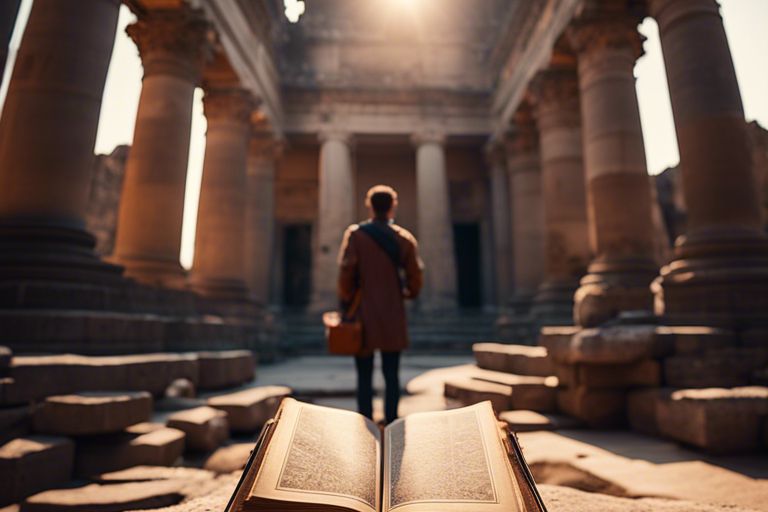Unravel the mysteries of ancient civilizations as we take you on a captivating journey through time and history. Delve into the wonders of past empires, architectural marvels, and cultural landmarks that have stood the test of time. From the grand pyramids of Egypt to the majestic ruins of Machu Picchu, each site holds a rich tapestry of stories waiting to be discovered. Join us as we explore these ancient marvels and unlock the secrets of our fascinating past.
The Cradles of Civilization
Mesopotamia: The Dawn of History
To explore the origins of civilization, one must journey back to Mesopotamia, the land between the Tigris and Euphrates rivers. It is here that the earliest known complex societies emerged, laying the foundation for human civilization. Mesopotamia was home to ancient city-states such as Sumer, Akkad, and Babylon, where advancements in agriculture, writing, mathematics, and governance revolutionized the way societies organized themselves.
The invention of writing in Mesopotamia around 3200 BCE marked a pivotal moment in human history, allowing for the documentation of laws, trade agreements, and epic tales of gods and heroes. The Mesopotamians also developed sophisticated irrigation systems to support their agricultural endeavors, enabling surplus food production and the growth of urban centers.
Egypt: The Eternal Kingdom of the Pharaohs
To the west of Mesopotamia lies ancient Egypt, renowned for its majestic pyramids, enigmatic hieroglyphs, and powerful pharaohs. The Nile River served as the lifeblood of Egyptian civilization, providing fertile land for farming and transportation. The Egyptians excelled in architecture, art, and religion, leaving behind a rich legacy that continues to captivate the world.
The pharaohs of Egypt were not only political leaders but also divine figures believed to possess the authority to communicate with the gods. The pyramids, built as tombs for these rulers, stand as enduring testaments to their power and the society’s meticulous craftsmanship and engineering prowess.
Dawn of civilization in Egypt was marked by the unification of Upper and Lower Egypt by King Narmer around 3100 BCE, leading to the establishment of the first dynasty. This event laid the groundwork for the Old Kingdom, a period characterized by grand pyramid construction and centralized rule under pharaohs.
Architectural Genius Lost to Time
Obviously, as we investigate into the annals of history, we come across architectural marvels that time has obscured from our view. The craftsmanship and ingenuity of ancient civilizations continue to astound us, leaving a trail of architectural wonders that beckon us to explore further.
The Mysteries of the Maya and Aztecs
To unravel the mysteries of the Maya and Aztecs is to step into a world where advanced knowledge of astronomy and mathematics gave rise to breathtaking structures such as Chichen Itza and Teotihuacan. The precision of their architectural designs reflects a deep understanding of their environment and a reverence for the cosmos.
It is through the intricate carvings and grand pyramids that we catch a glimpse of the beliefs and rituals of these ancient civilizations. The Maya and Aztecs left behind not only impressive architectural feats but also a tapestry of symbolism that continues to intrigue and fascinate archaeologists and historians.
Secrets within the Stones of Machu Picchu
To uncover the secrets within the stones of Machu Picchu is to witness the mastery of the Inca civilization. The intricate masonry and sophisticated engineering of this mountaintop citadel defy conventional understanding, hinting at a level of sophistication that has eluded many for centuries.
It is believed that Machu Picchu served as a sacred site for religious ceremonies and astronomical observation, showcasing the profound connection the Inca people had with the natural world. The alignment of structures with celestial events and the harmonious integration with the surrounding landscape speak volumes about the cultural significance of this ancient wonder.
Intellectual Triumphs of the Ancient World
Despite the passage of millennia, the intellectual achievements of ancient civilizations continue to astound and inspire us. From philosophical inquiries to groundbreaking scientific discoveries, the ancient world was a hotbed of innovation and intellectual prowess. Let us explore some of the remarkable feats achieved by these early societies.
The Philosophical Prowess of Ancient Greece
For centuries, the thinkers of ancient Greece grappled with fundamental questions about the nature of reality, the essence of existence, and the meaning of life. Philosophers such as Socrates, Plato, and Aristotle laid the foundation for Western philosophy, shaping the way we approach knowledge and truth. Their ideas on ethics, politics, and metaphysics continue to influence modern thought, demonstrating the enduring legacy of their intellectual contributions.
The philosophical tradition of Ancient Greece not only laid the groundwork for Western philosophy but also inspired future generations to ponder the mysteries of the universe. The legacy of thinkers such as Pythagoras, Heraclitus, and Parmenides continues to challenge and provoke us, urging us to question our assumptions and seek deeper insights into the nature of reality.
The Scientific Achievements of the Golden Age of Islam
On the other side of the ancient world, the Golden Age of Islam witnessed a flourishing of scientific knowledge and innovation. From advances in medicine and astronomy to groundbreaking discoveries in mathematics and optics, Islamic scholars made significant contributions to various fields of study. Figures like Al-Kindi, Al- Khwarizmi, and Ibn al-Haytham paved the way for modern scientific inquiry, laying the groundwork for future developments in the sciences.
Prowess Despite the magnificent achievements of the Golden Age of Islam, the scientific contributions of Islamic scholars are often overlooked in mainstream narratives of history. It is crucial to highlight the valuable insights and discoveries made by these early scientists and mathematicians, as their work not only shaped the intellectual landscape of their time but also influenced the course of human knowledge for centuries to come.
Societal Structures and Daily Life
Rome: Power and People
Structures of power in ancient Rome were deeply ingrained in society, with a complex hierarchy that governed all aspects of daily life. At the top of the social ladder were the elite patrician class, who held positions of authority in government, the military, and religious affairs. Beneath them were the plebeians, common citizens who made up the majority of the population and worked in various trades and professions.
The daily life of Romans revolved around family, work, and civic responsibilities. Families typically lived in multi-story apartment buildings called insulae, where they would eat, socialize, and relax. Romans also enjoyed public baths, theaters, and gladiatorial games, which were popular forms of entertainment.
Feudal Life and Legacy in Medieval Europe
Legacy Feudalism was a dominant social and economic system in medieval Europe, characterized by the exchange of land for loyalty and military service. At the top of the feudal hierarchy was the monarch, who granted land to nobles in exchange for their allegiance and military support. The nobles, in turn, divided their land among vassals who provided them with troops in times of war.
Feudal life in medieval Europe was centered around the manor, a self-sufficient estate where peasants worked the land in exchange for protection from the lord. Daily life revolved around agricultural labor, religious observance, and seasonal festivals that marked the passage of time.
To understand the legacy of feudalism in medieval Europe, it is important to recognize its lasting impact on European society. Feudal relationships shaped the political, social, and economic structures of the time, influencing everything from land distribution to the rise of centralized monarchies in the later Middle Ages.
Faith and Mythology
Your journey through ancient marvels takes you deep into the realm of faith and mythology, where legends intertwine with the fabric of history, shaping civilizations and belief systems across the globe.
Norse Legends and Viking Valor
For centuries, Norse mythology has captivated minds with its tales of gods, giants, and heroic warriors. The Vikings, known for their seafaring prowess and fearless conquests, believed in a pantheon of deities led by Odin, the Allfather. Tales of Thor, the thunder god, and Loki, the trickster, resonate through time, reflecting the values and fears of ancient Norse society.
Exploring the rich tapestry of Norse legends reveals a world where honor, courage, and loyalty were paramount virtues. The epic sagas convey themes of destiny, struggle, and sacrifice, painting a vivid picture of a culture shaped by the harsh realities of a formidable landscape and brutal warfare.
The Pantheon of Hindu Gods and Indian Epics
Legends from Hindu mythology stand as a testament to the vibrant tapestry of beliefs that have defined Indian culture for millennia. The pantheon of Hindu gods, with deities such as Brahma, Vishnu, and Shiva, embody the various aspects of creation, preservation, and destruction, forming a complex cosmic hierarchy that mirrors the cycles of life and rebirth.
Exploring Indian epics like the Mahabharata and Ramayana unveils profound narratives of duty, love, and honor, set against the backdrop of ancient kingdoms and divine intervention. These timeless stories serve as moral guides and cultural touchstones, offering insights into the values and traditions that have shaped the Indian subcontinent.
A deeper dive into the vast array of Hindu gods reveals a diverse pantheon with each deity representing different forces of nature, virtues, or aspects of the divine. From the benevolent goddess Lakshmi, symbolizing wealth and prosperity, to the fierce warrior goddess Durga, embodiment of strength and protection, these divine beings hold sway over various facets of human existence and the cosmos.
Rediscovering The Past Through Modern Eyes
Now is the time to explore into the depths of history and uncover the ancient marvels that have shaped our world. With modern technology at our fingertips, we are able to unravel the mysteries of the past like never before. Embarking on a journey through time and history allows us to gain a deeper understanding of our roots and the civilizations that came before us.
The Role of Archaeology
On the frontier of historical exploration stands the discipline of archaeology. Through meticulous excavations and analysis, archaeologists piece together the fragments of lost civilizations and shed light on their customs, beliefs, and daily lives. By studying artifacts and structures left behind by our ancestors, we can reconstruct the past and connect with our heritage in meaningful ways.
Archaeology plays a crucial role in bridging the gap between the past and present. By uncovering and preserving ancient sites, archaeologists provide valuable insights into how civilizations thrived and eventually declined. Their work not only helps us understand where we come from, but also offers valuable lessons for the future.
Preserving Our Global Heritage for Future Generations
Archaeology is not just about uncovering the past; it is also about preserving it for future generations. As ancient sites face threats from development, climate change, and neglect, it is imperative to protect these valuable remnants of human history. By safeguarding our global heritage, we ensure that our descendants can continue to learn from and be inspired by the achievements of those who came before us.
Conclusion
Conclusively, begining on a journey through time and history to unravel ancient marvels is a rewarding experience that allows us to research into the mysteries of the past and gain a deeper understanding of our world. By exploring ancient civilizations, artifacts, and architectural wonders, we can appreciate the ingenuity and creativity of those who came before us. This journey not only helps us connect with our roots but also provides valuable insights into the evolution of human society. So, let us continue to explore and preserve these ancient marvels for future generations to appreciate and learn from.


